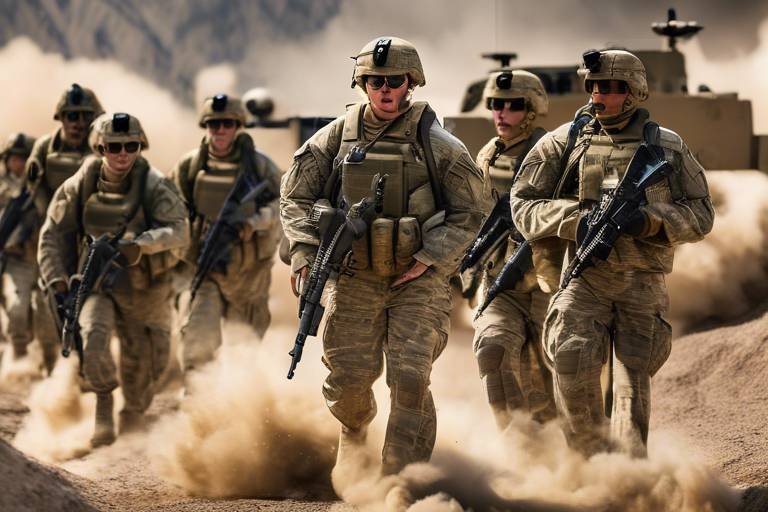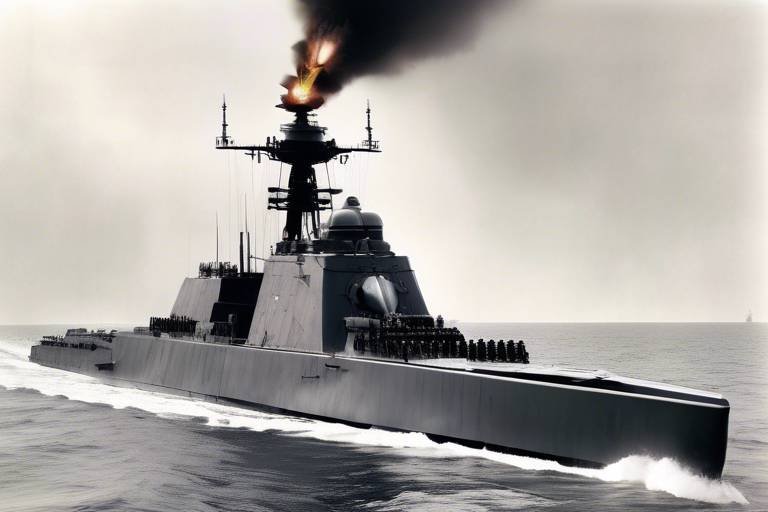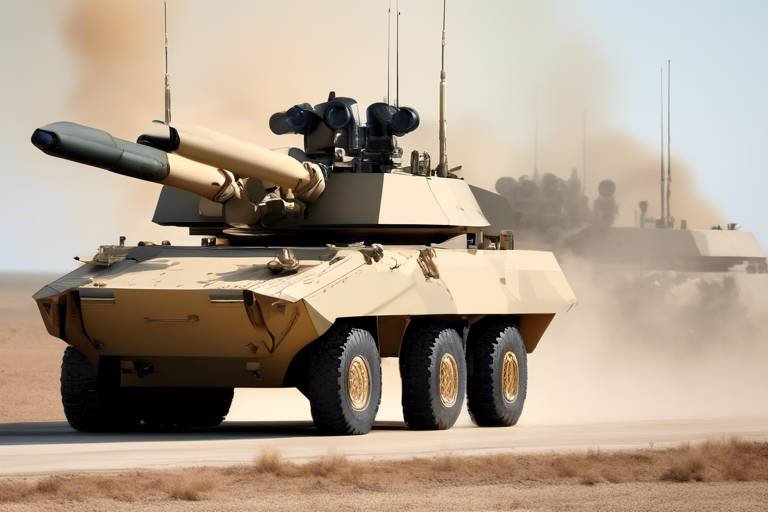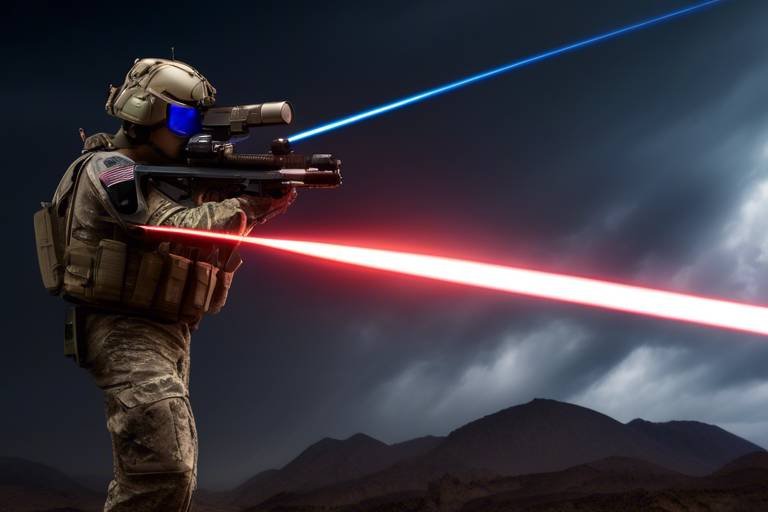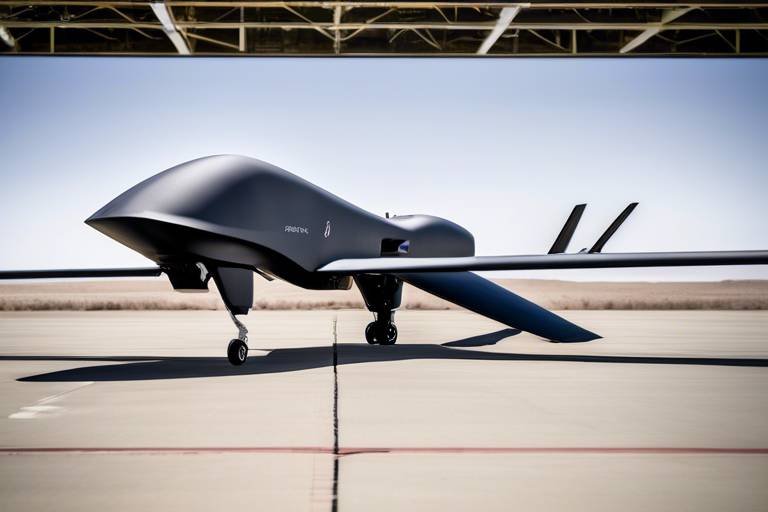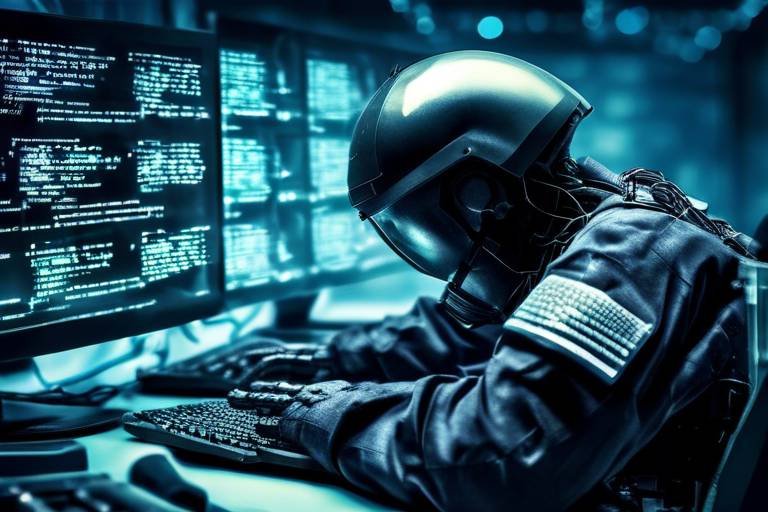Evaluating the Role of Advanced Surveillance Drones in Defense
In today's rapidly evolving military landscape, the role of advanced surveillance drones cannot be overstated. These high-tech flying machines have revolutionized modern defense strategies, providing unparalleled capabilities that enhance situational awareness and operational efficiency. Imagine a bird's-eye view of the battlefield, where every movement is monitored and analyzed in real-time. This is not just a fantasy; it is the reality that advanced surveillance drones bring to the table.
As nations invest heavily in drone technology, the implications for military operations and security protocols are profound. No longer are we confined to traditional methods of reconnaissance; drones have ushered in a new era of intelligence gathering that is both dynamic and efficient. With their ability to fly at various altitudes and cover vast distances, these drones are crucial in gathering critical information that can influence the outcome of military engagements.
But what exactly makes these drones so significant? For starters, they are equipped with cutting-edge sensors that allow for the collection of high-resolution imagery and data. This capability is not just about taking pictures; it’s about gathering actionable intelligence that can inform strategic decisions. The integration of advanced technologies, such as artificial intelligence and machine learning, enables drones to analyze data on the fly, providing commanders with insights that were previously unimaginable.
Furthermore, the operational flexibility of surveillance drones is remarkable. They can be deployed in various scenarios, from reconnaissance missions to target acquisition. This versatility means that they are not only valuable in combat situations but also in humanitarian missions, disaster response, and surveillance of potential threats. Their presence on the battlefield can often deter adversaries, knowing that they are being watched from above.
However, with great power comes great responsibility. The deployment of surveillance drones raises critical ethical considerations that cannot be ignored. As we embrace this technology, we must also address the implications it has on privacy and civilian safety. The question arises: how do we balance the need for security with the rights of individuals? This ongoing debate is essential as we navigate the complexities of modern warfare.
In summary, advanced surveillance drones are not just tools of war; they are game-changers that redefine how military operations are conducted. Their ability to provide real-time intelligence, coupled with their integration into broader military strategies, makes them indispensable in contemporary defense. As we continue to explore the capabilities of these drones, we must remain vigilant about the ethical implications that accompany their use, ensuring that we harness their power responsibly.
- What are advanced surveillance drones used for?
Advanced surveillance drones are primarily used for reconnaissance, intelligence gathering, target acquisition, and monitoring military operations in real-time.
- How do surveillance drones enhance military operations?
They provide critical data and situational awareness, allowing military commanders to make informed decisions quickly, which can lead to improved operational success.
- What are the ethical concerns surrounding drone surveillance?
Key concerns include privacy issues for civilians, the potential for misuse of surveillance data, and the need for accountability in military operations involving drones.
- How do drones integrate with other military assets?
Surveillance drones work in conjunction with satellites, ground forces, and other technologies to enhance communication and coordination, improving overall operational effectiveness.

Technological Advancements in Drone Surveillance
Recent innovations in drone technology have dramatically transformed the landscape of surveillance, making it a game-changer in modern defense strategies. Drones are no longer just remote-controlled gadgets; they have evolved into sophisticated systems equipped with cutting-edge technologies that enhance their operational capabilities. Imagine having the ability to monitor vast areas from the sky, gathering real-time data while keeping personnel safe on the ground. This is the reality that advanced surveillance drones bring to the table.
One of the most significant advancements in drone surveillance is the integration of high-resolution cameras and advanced sensor technologies. These drones can capture stunningly clear images and videos, even in challenging conditions. For instance, thermal imaging capabilities allow operators to detect heat signatures, making it possible to identify targets or track movements in complete darkness or through dense foliage. The combination of these technologies not only enhances situational awareness but also provides critical intelligence that can be pivotal in military operations.
Moreover, the advent of autonomous flight capabilities has revolutionized how drones operate. With the help of artificial intelligence (AI) and machine learning algorithms, drones can now navigate complex environments and make decisions based on real-time data without human intervention. This autonomy allows for continuous surveillance missions that can last for hours or even days, significantly extending the operational reach of military forces. The ability to conduct long-duration missions without risking human lives is an invaluable asset in today’s conflict zones.
Another technological leap is the development of data transmission technologies that enable drones to share information instantaneously with command centers. This real-time data sharing allows military leaders to make informed decisions quickly, adapting strategies on the fly based on the latest intelligence. Imagine a battlefield where commanders have access to live feeds from drones, allowing them to visualize the situation as it unfolds. This capability not only enhances operational success but also minimizes risks to personnel.
In addition to these advancements, drones are now equipped with multi-spectral sensors that can analyze various wavelengths of light. This means they can gather data beyond what the human eye can see, providing deeper insights into the environment. For example, these sensors can detect changes in vegetation health, which could indicate enemy activity or the presence of hidden installations. The ability to gather such diverse data sets is crucial for comprehensive situational analysis.
As we look towards the future, the potential for further advancements in drone surveillance technology is immense. Innovations such as swarm technology, where multiple drones work together to cover larger areas and share data among themselves, are on the horizon. This could lead to unprecedented levels of surveillance and intelligence-gathering capabilities, making it even more challenging for adversaries to hide their activities.
In conclusion, the technological advancements in drone surveillance are not just enhancing military operations; they are redefining them. With high-resolution imaging, autonomous capabilities, and advanced data transmission, surveillance drones are becoming indispensable tools in modern defense strategies. As these technologies continue to evolve, we can expect even greater impacts on military effectiveness and operational efficiency.

Applications of Surveillance Drones in Military Operations
Surveillance drones have revolutionized the landscape of military operations, providing capabilities that were once the stuff of science fiction. Imagine having a bird's-eye view of the battlefield, with the ability to gather critical intelligence without putting soldiers in harm's way. These unmanned aerial vehicles (UAVs) are not just flying cameras; they are sophisticated tools that enhance decision-making and operational efficiency. From reconnaissance missions to target acquisition, the applications of surveillance drones are diverse and impactful.
One of the primary roles of surveillance drones is in reconnaissance missions. These missions allow military forces to gather vital information about enemy positions, movements, and capabilities. With advanced imaging technology, drones can capture high-resolution images and videos, providing real-time insights that are crucial for strategic planning. This capability is particularly important in environments where traditional intelligence-gathering methods may be compromised or too risky.
Moreover, surveillance drones play a significant role in target acquisition. By identifying and tracking specific targets, these drones provide ground forces with the intelligence needed to execute precise strikes. This not only increases the effectiveness of military operations but also helps minimize collateral damage, which is a growing concern in modern warfare. The integration of drones into military strategies allows for a more calculated approach, reducing the risks associated with direct confrontations.
In addition to reconnaissance and target acquisition, surveillance drones are essential for real-time intelligence sharing. Imagine a scenario where a drone identifies an enemy unit on the move. With the ability to transmit information instantly to commanders, military leaders can make informed decisions quickly, adjusting strategies on the fly. This rapid response capability is invaluable in dynamic conflict situations where every second counts. The synergy between drones and ground forces enhances overall operational effectiveness, enabling a level of coordination that was previously unattainable.
Advanced sensors equipped on these drones facilitate remote sensing and data collection. This technology allows for the gathering of environmental data, which can be used to assess the battlefield's conditions. For instance, drones can monitor weather patterns, terrain features, and even civilian activities, providing a comprehensive picture that supports strategic planning. The data collected can be analyzed to improve operational efficiency, ensuring that military operations are conducted with the highest level of preparedness.
Furthermore, surveillance drones are designed to work in conjunction with other military assets, such as satellites and ground forces. This integration enhances communication and coordination across various units, creating a more cohesive operational strategy. For example, drones can relay information from the battlefield to command centers, ensuring that decision-makers have access to the latest intelligence. This collaborative approach not only improves situational awareness but also fosters a culture of teamwork among military units.
However, as surveillance drones become more prevalent, adversaries are also developing counter-surveillance measures. This ongoing cat-and-mouse game necessitates continuous innovation and adaptation within drone technology. To maintain an advantage, military forces must stay ahead of emerging threats, investing in advanced technologies that can counteract enemy tactics. This dynamic environment ensures that the role of surveillance drones in military operations will continue to evolve, adapting to new challenges and opportunities.
In conclusion, the applications of surveillance drones in military operations are vast and varied. From enhancing reconnaissance capabilities to facilitating real-time intelligence sharing, these drones have become indispensable tools in modern warfare. As technology continues to advance, the potential for further innovations in drone surveillance will only expand, shaping the future of military operations. The question remains: how will these developments impact the ethical considerations surrounding their use?
- What are the primary uses of surveillance drones in military operations?
Surveillance drones are primarily used for reconnaissance, target acquisition, and real-time intelligence sharing, enhancing operational efficiency and decision-making. - How do drones improve situational awareness on the battlefield?
Drones provide real-time data and high-resolution imagery, allowing military leaders to make informed decisions quickly and adjust strategies as needed. - What are the challenges associated with drone surveillance?
Challenges include the development of counter-surveillance measures by adversaries and ethical concerns regarding privacy and accountability.

Remote Sensing and Data Collection
In the realm of modern warfare, remote sensing and data collection have become pivotal elements that define the effectiveness of military operations. Advanced surveillance drones are equipped with cutting-edge sensors that capture high-resolution imagery and gather critical data from the battlefield. Imagine a bird's-eye view of a conflict zone, where every movement is documented with precision. This capability not only enhances situational awareness but also allows military leaders to make informed decisions based on real-time information.
These drones utilize a variety of technologies to collect data, including electro-optical sensors, infrared cameras, and synthetic aperture radar (SAR). Each of these technologies plays a unique role:
- Electro-Optical Sensors: Capture detailed images during the day, providing clarity in visual reconnaissance.
- Infrared Cameras: Enable night vision capabilities, allowing for surveillance in low-light conditions.
- Synthetic Aperture Radar (SAR): Penetrates cloud cover and can operate in any weather, ensuring continuous monitoring.
Furthermore, the data collected through these sensors is not just a collection of images; it is transformed into actionable intelligence. For instance, the integration of geospatial analysis allows military strategists to visualize data in a way that highlights patterns and trends, which can be crucial for assessing enemy movements or planning operations. This transformation of raw data into valuable insights is akin to turning a jigsaw puzzle into a clear picture, enabling commanders to see the bigger picture amidst the chaos of warfare.
Moreover, the ability to collect and analyze data in real-time is a game changer. Consider this: a drone flying over a battlefield can relay information back to command centers almost instantaneously. This rapid communication streamlines decision-making processes and enhances operational efficiency. Commanders can assess threats, allocate resources, and adjust strategies on the fly, leading to a more agile and responsive military force.
However, while the advantages of remote sensing and data collection are immense, they also come with challenges. The vast amount of data generated requires sophisticated data management systems to ensure that information is processed, analyzed, and disseminated effectively. Military organizations must invest in advanced technologies and trained personnel to harness the full potential of these surveillance systems.
In summary, remote sensing and data collection through advanced surveillance drones represent a significant leap in military capabilities. They not only enhance situational awareness but also facilitate informed decision-making, ultimately leading to improved operational success. As technology continues to evolve, the role of these drones will undoubtedly become even more critical in shaping the future of military operations.
- What are the primary functions of surveillance drones? Surveillance drones are primarily used for reconnaissance, target acquisition, and real-time intelligence gathering.
- How do surveillance drones collect data? They utilize advanced sensors such as electro-optical cameras, infrared sensors, and synthetic aperture radar to gather high-resolution imagery and data.
- What are the ethical concerns surrounding the use of surveillance drones? Ethical concerns include privacy issues, the potential for civilian casualties, and the need for accountability in military operations.
- Can surveillance drones operate in adverse weather conditions? Yes, certain drones equipped with synthetic aperture radar can operate effectively in poor weather, allowing for continuous surveillance.

Integration with Other Military Assets
In the ever-evolving landscape of modern warfare, the integration of surveillance drones with other military assets has become a game-changer. Imagine a symphony where each instrument plays in harmony to create a powerful melody; this is akin to how drones, satellites, ground forces, and command centers collaborate to enhance operational effectiveness. By working together, these assets create a comprehensive picture of the battlefield, ensuring that military leaders have the best possible information at their fingertips.
Surveillance drones are not standalone entities; they are vital components of a larger military ecosystem. For instance, when a drone captures high-resolution imagery of enemy positions, that data can be instantly relayed to ground troops and command centers. This real-time communication allows for swift adjustments in strategy, akin to a quarterback making a split-second decision on the field. The ability to coordinate actions across various platforms significantly boosts the chances of mission success.
Moreover, the integration of drones with satellite technology enhances the scope of surveillance operations. Satellites provide a broad overview of areas that may be difficult for ground forces to access. When combined with the detailed, localized data from drones, military planners can develop a more nuanced understanding of the operational environment. This synergy also aids in target acquisition, as drones can identify and relay specific coordinates to artillery units, ensuring precise strikes that minimize collateral damage.
To illustrate this integration further, consider the following table that highlights the key assets involved in military operations and how they interconnect:
| Military Asset | Function | Integration Benefits |
|---|---|---|
| Surveillance Drones | Real-time reconnaissance and data collection | Provides immediate intelligence to ground forces |
| Satellites | Global surveillance and communication | Offers a broad view of battlefield dynamics |
| Ground Forces | Engagement and tactical maneuvers | Receives actionable intelligence for strategic decisions |
| Command Centers | Strategic planning and coordination | Facilitates real-time decision-making |
This interconnectedness also fosters a culture of collaborative warfare, where each unit understands its role within the broader mission. For example, a drone operator can communicate directly with ground troops to adjust flight paths based on real-time feedback, ensuring that the drone's observations are most relevant to the current tactical scenario. This level of integration minimizes the fog of war, allowing military leaders to make informed decisions swiftly.
However, the integration of surveillance drones with other military assets is not without its challenges. Issues such as data overload, communication lags, and the need for extensive training can complicate operations. Military forces must continually adapt and innovate to overcome these hurdles, ensuring that the integration remains seamless and effective.
In summary, the integration of surveillance drones with other military assets is a crucial aspect of modern defense strategies. This collaboration not only enhances situational awareness but also allows for more precise and effective military operations. As technology continues to advance, the potential for even greater integration and synergy among military assets will undoubtedly shape the future of warfare.
- What are surveillance drones used for in military operations?
Surveillance drones are primarily used for reconnaissance, target acquisition, and gathering real-time intelligence to support ground forces and command decisions. - How do surveillance drones enhance operational effectiveness?
By providing real-time data and integrating with other military assets, drones improve situational awareness and facilitate quicker, more informed decision-making. - What challenges exist in integrating drones with other military assets?
Challenges include data overload, communication lags, and the need for extensive training to ensure all units can effectively collaborate.

Real-time Intelligence Sharing
In the fast-paced world of modern warfare, the ability to share intelligence in real-time is nothing short of revolutionary. Imagine a battlefield where every second counts, and the difference between success and failure hinges on the speed of information flow. This is where advanced surveillance drones come into play, acting as the eyes in the sky that not only gather data but also transmit it instantly to ground forces and command centers. The integration of drone technology with communication systems ensures that critical information reaches decision-makers without delay, enhancing the overall effectiveness of military operations.
Real-time intelligence sharing through drones can significantly improve response times. For instance, when a drone identifies a potential threat or an emerging situation, the data is sent directly to the command unit. This allows for immediate analysis and decision-making, enabling commanders to deploy resources swiftly and effectively. It's like having a personal assistant who not only keeps you informed but also anticipates your needs before you even ask. This capability can be a game-changer in high-stakes environments where every moment matters.
Moreover, the data collected by surveillance drones is not just limited to visual imagery; it can include various forms of intelligence such as infrared readings, electronic signals, and even biometric data. This multifaceted approach to intelligence gathering allows for a comprehensive understanding of the battlefield. To illustrate this point, consider the following table that highlights the different types of data shared in real-time:
| Type of Data | Description |
|---|---|
| Visual Imagery | High-resolution images captured by drones for reconnaissance. |
| Infrared Readings | Heat signatures that help identify hidden threats or troop movements. |
| Electronic Signals | Intercepted communications that provide insights into enemy plans. |
| Biometric Data | Information such as fingerprints or facial recognition for target identification. |
This wealth of information allows military leaders to make informed decisions based on a holistic view of the situation. Furthermore, the real-time aspect ensures that even as conditions change, the intelligence remains current and actionable. It's akin to having a live feed of a sports game, where the coach can make strategic adjustments based on the unfolding action.
However, the benefits of real-time intelligence sharing also come with challenges. The more data that flows, the greater the need for robust security measures to protect sensitive information from adversaries. In this digital age, where cyber threats are rampant, ensuring that the data shared remains secure is paramount. Military forces must continuously innovate and adapt their technology to stay one step ahead of those who seek to exploit vulnerabilities.
In conclusion, real-time intelligence sharing facilitated by advanced surveillance drones is a critical component of modern military strategy. It enhances operational effectiveness, improves response times, and provides a comprehensive understanding of the battlefield. Yet, with great power comes great responsibility; maintaining data security and ethical considerations remains essential in this ever-evolving landscape.
- What are the main advantages of using surveillance drones in military operations?
Surveillance drones offer several advantages, including real-time data collection, improved situational awareness, and enhanced communication among military units.
- How do drones share intelligence in real-time?
Drones are equipped with advanced communication systems that allow them to transmit data instantly to command centers and ground forces, ensuring timely decision-making.
- What types of data can surveillance drones collect?
Drones can collect various types of data, including visual imagery, infrared readings, electronic signals, and biometric information.
- What are the ethical concerns associated with drone surveillance?
Ethical concerns include privacy issues, civilian safety, and the need for accountability and oversight in drone operations.

Counter-Surveillance Measures
As the battlefield evolves, so too do the tactics employed by adversaries. The rise of advanced surveillance drones has prompted a significant shift in military strategy, leading to the development of . These measures are designed to neutralize the effectiveness of drones and protect sensitive information. Imagine a game of chess where each move is countered by a strategic response; this is precisely what is happening in the realm of drone warfare.
Adversaries are increasingly investing in technologies that can detect, jam, or even take control of surveillance drones. For instance, signal jamming can disrupt the communication links between a drone and its operators, rendering it useless. Moreover, anti-drone systems equipped with radar and other detection technologies are being deployed to identify and intercept drones before they can gather critical intelligence. These systems are akin to a digital fortress, safeguarding a nation’s secrets against aerial intruders.
In addition to technological advancements, the human element plays a crucial role in counter-surveillance. Military personnel are trained to recognize drone activity and implement tactics to evade detection. This might involve using camouflage or adopting deception techniques to mislead drones. For example, ground forces may create decoy signals that mimic their own communications, effectively confusing the drone's sensors.
Another innovative approach involves the use of counter-drone drones. These specialized drones are designed to intercept and disable enemy surveillance drones, turning the tables in this aerial arms race. Equipped with nets or other disabling devices, they can effectively neutralize threats from above, much like a hawk swooping down on an intruding sparrow.
However, the arms race in counter-surveillance is not without its challenges. As drone technology continues to advance, so do the tactics to counteract them. This ongoing cycle of innovation requires military forces to remain vigilant and adaptable. The effectiveness of counter-surveillance measures hinges on a comprehensive understanding of both drone capabilities and the evolving landscape of threats. In this high-stakes game, staying one step ahead is not just an advantage; it’s a necessity.
Ultimately, the implementation of counter-surveillance measures highlights the dynamic nature of modern warfare. As drones become more sophisticated, the methods to counter them must also evolve. This relentless pursuit of technological superiority underscores the importance of ongoing research and development in military strategy.
- What are counter-surveillance measures? Counter-surveillance measures are strategies and technologies used to detect, neutralize, or evade surveillance drones.
- How do signal jammers work? Signal jammers disrupt the communication between a drone and its operator, preventing the drone from transmitting data or receiving commands.
- What role do counter-drone drones play? Counter-drone drones are designed to intercept and disable enemy surveillance drones, providing a proactive defense against aerial threats.
- Why is ongoing innovation important in counter-surveillance? As drone technology advances, new counter-surveillance strategies must be developed to maintain a tactical advantage in military operations.

Ethical Considerations in Drone Surveillance
The deployment of surveillance drones has sparked a heated debate around ethical considerations that challenge our understanding of privacy, security, and accountability. As these advanced technologies become more integrated into military operations, the implications for civilian life and individual rights cannot be overlooked. Are we sacrificing too much in the name of security? This question is at the heart of the ongoing discussions surrounding drone surveillance.
One of the most pressing concerns is the issue of privacy. Surveillance drones, equipped with high-resolution cameras and advanced sensors, can capture detailed images and data from vast distances. This capability raises significant ethical dilemmas, particularly when drones are deployed in populated areas. The potential for constant monitoring creates a sense of unease among civilians, who may feel that their daily activities are under scrutiny. The balance between ensuring national security and protecting individual rights is a delicate one, and many argue that regulations are necessary to prevent invasive surveillance practices.
Furthermore, the use of drones in military operations often leads to questions about accountability and oversight. When decisions are made based on data collected from drones, who is responsible for those decisions? The lack of clear accountability can lead to serious consequences, including civilian casualties and violations of human rights. In response to these concerns, there have been growing calls for increased transparency in drone operations. Establishing clear operational protocols and oversight mechanisms is essential for maintaining public trust and ensuring that drone technology is used responsibly.
In addition to privacy and accountability, the implications of automated decision-making in military contexts also warrant attention. As drones become more autonomous, the potential for automated systems to make life-and-death decisions raises ethical questions about the role of human judgment in warfare. Can machines truly understand the complexities of human life? The reliance on algorithms and artificial intelligence in military operations could lead to unintended consequences, making it crucial to establish ethical guidelines that govern the use of such technologies.
To further illustrate these ethical considerations, let's take a look at some key points:
| Ethical Consideration | Description |
|---|---|
| Privacy | Concerns over constant surveillance and the potential invasion of personal privacy. |
| Accountability | The need for clear responsibility in decision-making processes involving drone operations. |
| Automated Decision-Making | Ethical implications of allowing machines to make critical decisions in military contexts. |
In conclusion, the ethical considerations surrounding drone surveillance are multifaceted and complex. As technology continues to evolve, it is imperative that we engage in ongoing discussions about how to balance security needs with the rights of individuals. The future of drone surveillance will depend not only on technological advancements but also on our commitment to ethical principles that protect the values we hold dear.
- What are the main ethical concerns regarding drone surveillance?
Key concerns include privacy invasion, accountability for decisions made based on drone data, and the implications of automated decision-making in military contexts.
- How can regulations help address privacy issues?
Regulations can establish boundaries for drone operations, ensuring that surveillance is conducted with respect for individual rights and that there are consequences for violations.
- What role does accountability play in drone operations?
Accountability ensures that there is a clear chain of responsibility for decisions made based on drone surveillance, which is vital for maintaining public trust.

Privacy Concerns
As surveillance drones soar through the skies, their presence raises significant privacy concerns that cannot be overlooked. Imagine a world where the watchful eyes of drones are constantly scanning our neighborhoods, capturing every moment of our daily lives. This reality prompts a crucial question: how do we balance the need for security with the fundamental right to privacy? The growing use of drones in populated areas has sparked debates about the extent to which these flying machines can intrude into our personal spaces.
One of the primary issues is the potential for unwarranted surveillance. Drones equipped with high-resolution cameras can capture images and videos from great heights, leading to fears that individuals may be monitored without their consent. This concern is amplified in urban settings, where the line between public and private spaces becomes blurred. A drone hovering above a park, for instance, could inadvertently record personal conversations or activities, raising ethical dilemmas about what constitutes acceptable surveillance.
Moreover, the legal framework surrounding drone usage is still evolving. Many countries are grappling with how to regulate drone surveillance effectively, often lagging behind the rapid technological advancements. As a result, there are inconsistencies in laws related to privacy rights and drone operations. Citizens may find themselves caught in a legal gray area where their rights are not adequately protected, leading to a sense of vulnerability.
To address these concerns, it is essential to establish clear regulations governing the use of surveillance drones. These regulations should include guidelines on where drones can operate, what data they can collect, and how that data can be stored and used. Public awareness and education about drone capabilities and limitations are also crucial. If people understand how drones work and the measures in place to protect their privacy, they may feel more secure and less threatened.
Furthermore, the implementation of oversight mechanisms is vital. Ensuring that drone operations are monitored by independent bodies can help maintain public trust. This oversight could involve regular audits of drone activities, transparency in data collection practices, and mechanisms for individuals to report privacy violations. By fostering a culture of accountability, we can mitigate the risks associated with drone surveillance while still reaping the benefits of advanced technology.
In conclusion, while advanced surveillance drones offer numerous advantages for security and military operations, the they raise are equally significant. As society navigates this complex landscape, it is imperative to strike a balance that protects individual rights without compromising national security. The conversation about privacy in the age of drones is just beginning, and it will require the collective effort of policymakers, technologists, and the public to ensure that our skies remain safe and our rights respected.
- What are the main privacy concerns associated with surveillance drones?
The main concerns include unwarranted surveillance, legal ambiguities, and the potential for data misuse.
- How can regulations help address privacy issues?
Regulations can provide clear guidelines on drone operations, data collection, and individual rights, ensuring a balance between security and privacy.
- What role does public awareness play in drone surveillance?
Public awareness helps individuals understand their rights and the operational limits of drones, fostering a sense of security and trust.
- Why is oversight important in drone operations?
Oversight ensures accountability and transparency, helping to maintain public trust in drone surveillance practices.

Accountability and Oversight
As the deployment of surveillance drones continues to grow, the issue of accountability becomes increasingly paramount. The very nature of drone operations, which often occur remotely and involve advanced technology, raises significant concerns about who is responsible when things go awry. In many cases, the decision-making process is not just about the technology itself but also about the individuals and organizations that operate these drones. This leads us to ponder: how can we ensure that there are adequate checks and balances in place to maintain public trust?
To address these concerns, there are several key areas that need to be considered:
- Clear Operational Protocols: Establishing well-defined guidelines for drone operations is essential. This includes outlining the circumstances under which drones can be deployed, the types of surveillance permitted, and the limits of their capabilities.
- Training and Certification: Operators of surveillance drones should undergo rigorous training and certification processes to ensure they understand both the technology and the ethical implications of their use.
- Incident Reporting: Implementing a transparent incident reporting system can help track and analyze any mishaps that occur during drone operations. This would not only aid in accountability but also in improving future practices.
Moreover, the integration of oversight bodies is crucial. These organizations can provide independent assessments of drone operations, ensuring that they align with legal and ethical standards. For instance, a national oversight committee could be established to review drone usage across various sectors, including military and law enforcement. This committee would be responsible for:
| Oversight Function | Description |
|---|---|
| Policy Development | Creating guidelines for the ethical use of drones in surveillance. |
| Compliance Monitoring | Ensuring that drone operators adhere to established protocols. |
| Public Reporting | Providing regular updates to the public regarding drone operations and incidents. |
Ultimately, the goal of accountability and oversight in drone surveillance is to strike a balance between national security and individual rights. As technology evolves, so too must our frameworks for governance. The public deserves to know that their safety is being prioritized without infringing upon their privacy. By fostering a culture of transparency and responsibility, we can work towards a future where surveillance drones are used ethically and effectively.
- What are the main responsibilities of drone operators? Drone operators are responsible for adhering to established protocols, ensuring the ethical use of technology, and reporting any incidents that may occur during operations.
- How can the public ensure that drone surveillance is conducted ethically? The public can advocate for transparency and accountability measures, such as independent oversight committees and incident reporting systems.
- What are the potential consequences of inadequate oversight? Without proper oversight, there may be violations of privacy, misuse of surveillance data, and a general lack of public trust in drone operations.
Frequently Asked Questions
- What are advanced surveillance drones?
Advanced surveillance drones are unmanned aerial vehicles equipped with cutting-edge technology that allows them to gather real-time data, capture high-resolution imagery, and provide critical intelligence for military operations. Think of them as the eyes in the sky that help commanders see what’s happening on the battlefield without putting personnel at risk.
- How do surveillance drones improve military operations?
Surveillance drones enhance military operations by providing timely reconnaissance, facilitating target acquisition, and enabling remote sensing. This means that ground forces can access vital information quickly, leading to better decision-making and improved response times during missions. It’s like having a strategic partner that never sleeps!
- What are the ethical concerns surrounding drone surveillance?
Ethical concerns include privacy issues, especially when drones operate in populated areas, and the potential for automated decision-making in military contexts. Many people worry that the use of drones could infringe on individual rights, leading to a call for regulations to ensure a balance between security and privacy. It’s a tricky tightrope to walk!
- How do drones share intelligence in real-time?
Surveillance drones are equipped with advanced communication systems that allow them to transmit data and imagery back to command centers instantly. This real-time sharing of intelligence enables military leaders to make informed decisions quickly, much like how a quarterback communicates plays to their team on the field.
- What are counter-surveillance measures?
Counter-surveillance measures refer to tactics and technologies developed by adversaries to detect, disrupt, or disable surveillance drones. As drones become more integrated into military strategies, it’s essential for operators to stay one step ahead, continuously innovating to maintain their advantage. It’s a game of cat and mouse!
- Are there regulations governing the use of surveillance drones?
Yes, there are various regulations and guidelines in place to govern the use of surveillance drones, particularly concerning privacy and accountability. These rules aim to ensure that drone operations are conducted transparently and ethically, protecting both national security interests and individual rights.
- What role do advanced sensors play in drone surveillance?
Advanced sensors are crucial for drone surveillance as they enable the collection of high-resolution imagery and data. These sensors can capture detailed information that supports strategic planning and operational efficiency, making them indispensable tools for military intelligence. It’s like having a super-powered camera that can see everything!


